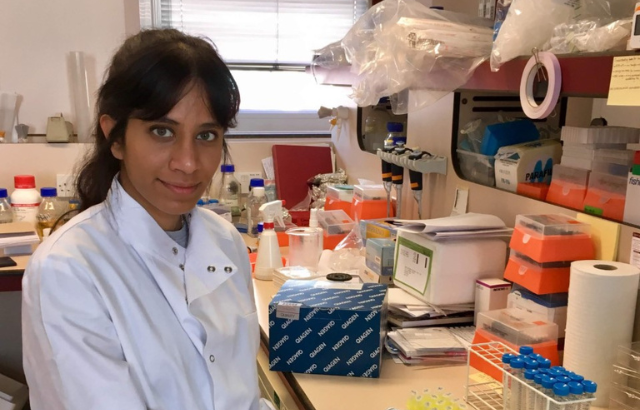Q&A: A satellite DNA array barcodes chromosome 7 and regulates totipotency via ZFP819
Dr Helen Rowe from the Centre for Immunobiology discusses her lab's recent article published in Science Advances. The team discovered that a certain satellite DNA barcode not only safeguards genome integrity, but also controls cell fate and reprogramming by promoting exit from totipotency and developmental progression.

First author, PhD student Liane Fernandes
Within the human genome, large stretches of DNA have an unknown function and are referred to as genomic ‘dark matter’. One type of dark matter consists of satellite DNAs, which are short units of DNA that are copied hundreds of times in tandem.
Satellite DNA units are especially densely packed at centromeres and telomeres, where they are thought to maintain chromosome structure. These satellite DNAs can arise due to DNA replication errors, since the sequences of each unit are so repetitive.
Satellite DNA instability is associated with cancers and neurological disorders, so preserving the correct regulation of this dark part of our genome is central to safeguarding our genome and to healthy ageing.
What is new about the research?
Until now, little has been understood about how satellite DNAs are regulated and what they do. Through a European Research Council starting grant, Dr Helen Rowe and her lab have been addressing this question using a mouse stem cell model and a satellite DNA array scattered across chromosome 7.
The team first identified a stretch of satellite DNAs, known as ZP3AR copies that were only present on mouse chromosomes 5 and 7. The chromosome 7 array, which spans a forty megabase region encompassing key developmental genes, resembles a barcode that binds a transcription factor known as KRAB-zinc finger protein 819 (ZFP819).
ZFP819 bridges silent chromatin (heterochromatin) to this satellite DNA array to switch it off and prevent it spreading further and causing chromosome instabilities.
Is there anything surprising?
.png)
Dr Helen Rowe
What was surprising about the study was that Dr Rowe’s team, led by dedicated PhD student Liane Fernandes, discovered that this satellite DNA barcode serves not only to safeguard genome integrity: Indeed, the array also controls cell fate and reprogramming by promoting exit from totipotency and developmental progression.
Totipotency refers to a stage in the early embryo defined by the potential to differentiate into all tissues, and embryonic stem cells can transition to a state with some similar features of this developmental stage, such as expression of an endogenous retrovirus, MERVL.
A master regulator of totipotency is the transcription factor, ZSCAN4, which is expressed in 2-cell stage embryos and maintains the telomeres of chromosomes. ZSCAN4 is encoded by a cluster of genes embedded within the satellite DNA array that Dr Rowe’s team have uncovered on chromosome 7.
The team found that, in mouse embryonic stem cells, ZFP819 recruits heterochromatin across the satellite array, thereby switching it off and switching of expression of ZSCAN4. In stem cells, this switch controls cell fate, whereas in development, we hypothesize that this mechanism is important to permit exit from the totipotent stage of development.
Inactivation of ZFP819 enables stem cells to reprogram to a more permissive state that resembles an earlier stage of development, where heterochromatin ‘roadblocks’ are lost genome-wide and ZSCAN4 is switched on.
What are the wider implications?
This work is important to the generation of stem-cell based therapies and has wider implications for our understanding of how cancer arises. For example, cancer stem cells are thought to be central to the initiation of tumours, as well as to the cause of relapses of cancer.
This is because they represent cells that have reprogrammed to a progenitor-like state that can seed the continual growth of a tumour and resist detection by the immune system. Thus, cancer cells hijack developmental pathways in order to transition to a stem-like state through unknown means.
It has recently been revealed that switching on human ZSCAN4 expression is at the heart of enabling cancer stem cells to form tumourspheres. Our work, here uncovers the mode of how the ON-OFF switch of ZSCAN4 expression is controlled.
Although our study is in mouse embryonic stem cells, we expect that a common mechanism will be in operation in human cells and uncovering this represents an important future direction of our work. It has already been shown that ZSCAN4 is expressed in early human embryos, although it is not yet known how human ZSCAN4 is regulated.
This study is not only relevant to the cancer and development fields: It also reveals a new mode of gene regulation through satellite DNA arrays that act as ‘barcodes’ for chromosomes, and which control gene networks through master transcription factors. By analogy, this barcoding mechanism may apply to other networks of genes, such as those involved in immunity for example.
More information
This work was made possible through funding from the European Research Council, which supported Liane and two talented postdoctoral researchers in Dr Rowe’s lab, Rocio Enriquez-Gasca and Poppy Gould who have helped with this work. The project also involved key collaborations with Investigators at the Francis Crick Institute (George Kassiotis), the Ecole Polytechnic Federale de Lausanne (Didier Trono) and UCL Cancer Institute (Javier Herrero).
Research article: Fernandes, L.P., Enriquez-Gasca, R., Gould, P.A., Holt, J.H., Conde, L., Ecco, G., Herrero, J., Gifford, R., Trono, D., Kassiotis, G. and Rowe, H.M. (2022). A satellite DNA array barcodes chromosome 7 and regulates totipotency via ZFP819. Science Advances, 8(43). doi:10.1126/sciadv.abp8085.
Read the open access article about this ERC-funded project written by Dr Helen Rowe.